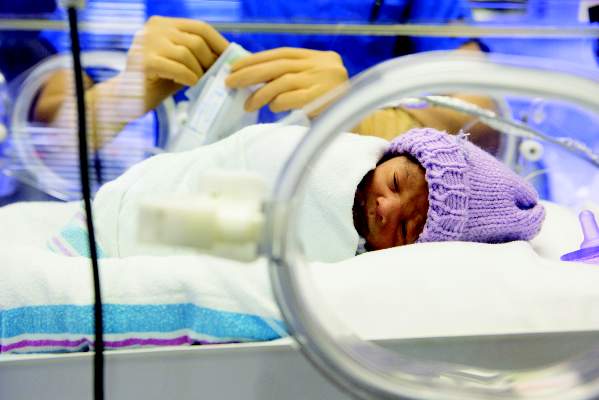User login
SAN DIEGO – Prophylactic indomethacin does not have any association with reducing the risk of bronchopulmonary dysplasia (BPD) or death in infants born extremely premature, according to an observational study presented by Dr. Erik Jensen, a neonatologist at the Children’s Hospital of Philadelphia, at the annual meeting of the Pediatric Academic Societies.
“Observational studies consistently show that patent ductus arteriosus [PDA] is a strong risk factor for [BPD] in very preterm infants [but] it remains uncertain whether PDA is a cause, or simply a marker, of increased BPD risk,” said Dr. Jensen. “Data from randomized trials indicate that prophylactic indomethacin reduces the risk of subsequent symptomatic PDA, yet there is no evidence from these studies that prophylactic indomethacin reduces BPD.”
Infants in the study who received prophylactic indomethacin experienced BPD at a rate of 44%, the exact same as those who did not receive prophylactic indomethacin. The rates of death before 36 weeks postmenstrual age also were not significantly different: 17% in infants receiving prophylactic indomethacin vs. 13% in infants who did not. Death or BPD occurred in 54% of prophylactic indomethacin subjects, and in 51% of infants who did not receive prophylactic indomethacin. An infant was defined as having BPD if they received supplemental oxygen at 36 weeks postmenstrual age.
All subjects in the study were enrolled in the Eunice Kennedy Shriver National Institute of Child Health and Human Development’s Neonatal Research Network generic database between 2008 and 2012, and were less than 29 weeks’ gestational age. The mean age of infants who received prophylactic indomethacin was 25.9 weeks, and the mean age was 26.7 weeks for infants who did not (P < .001). Mean body weight was 777 g for those who received prophylactic indomethacin vs. 912 g for those who did not (P < .001). Males made up 49% of the prophylactic indomethacin cohort and 52% of the other cohort (P < .006).
In total, 8,039 infants were included in the study, with 2,671 receiving prophylactic indomethacin and 5,368 infants who did not receive the drug; of those, commencement of PDA treatment was variable from center to center. PDA treatment after day 1 occurred in 21% of infants who received prophylactic indomethacin, and in 36% of those who did not (P < .001).
Dr. Jensen did not report any relevant financial disclosures.
SAN DIEGO – Prophylactic indomethacin does not have any association with reducing the risk of bronchopulmonary dysplasia (BPD) or death in infants born extremely premature, according to an observational study presented by Dr. Erik Jensen, a neonatologist at the Children’s Hospital of Philadelphia, at the annual meeting of the Pediatric Academic Societies.
“Observational studies consistently show that patent ductus arteriosus [PDA] is a strong risk factor for [BPD] in very preterm infants [but] it remains uncertain whether PDA is a cause, or simply a marker, of increased BPD risk,” said Dr. Jensen. “Data from randomized trials indicate that prophylactic indomethacin reduces the risk of subsequent symptomatic PDA, yet there is no evidence from these studies that prophylactic indomethacin reduces BPD.”
Infants in the study who received prophylactic indomethacin experienced BPD at a rate of 44%, the exact same as those who did not receive prophylactic indomethacin. The rates of death before 36 weeks postmenstrual age also were not significantly different: 17% in infants receiving prophylactic indomethacin vs. 13% in infants who did not. Death or BPD occurred in 54% of prophylactic indomethacin subjects, and in 51% of infants who did not receive prophylactic indomethacin. An infant was defined as having BPD if they received supplemental oxygen at 36 weeks postmenstrual age.
All subjects in the study were enrolled in the Eunice Kennedy Shriver National Institute of Child Health and Human Development’s Neonatal Research Network generic database between 2008 and 2012, and were less than 29 weeks’ gestational age. The mean age of infants who received prophylactic indomethacin was 25.9 weeks, and the mean age was 26.7 weeks for infants who did not (P < .001). Mean body weight was 777 g for those who received prophylactic indomethacin vs. 912 g for those who did not (P < .001). Males made up 49% of the prophylactic indomethacin cohort and 52% of the other cohort (P < .006).
In total, 8,039 infants were included in the study, with 2,671 receiving prophylactic indomethacin and 5,368 infants who did not receive the drug; of those, commencement of PDA treatment was variable from center to center. PDA treatment after day 1 occurred in 21% of infants who received prophylactic indomethacin, and in 36% of those who did not (P < .001).
Dr. Jensen did not report any relevant financial disclosures.
SAN DIEGO – Prophylactic indomethacin does not have any association with reducing the risk of bronchopulmonary dysplasia (BPD) or death in infants born extremely premature, according to an observational study presented by Dr. Erik Jensen, a neonatologist at the Children’s Hospital of Philadelphia, at the annual meeting of the Pediatric Academic Societies.
“Observational studies consistently show that patent ductus arteriosus [PDA] is a strong risk factor for [BPD] in very preterm infants [but] it remains uncertain whether PDA is a cause, or simply a marker, of increased BPD risk,” said Dr. Jensen. “Data from randomized trials indicate that prophylactic indomethacin reduces the risk of subsequent symptomatic PDA, yet there is no evidence from these studies that prophylactic indomethacin reduces BPD.”
Infants in the study who received prophylactic indomethacin experienced BPD at a rate of 44%, the exact same as those who did not receive prophylactic indomethacin. The rates of death before 36 weeks postmenstrual age also were not significantly different: 17% in infants receiving prophylactic indomethacin vs. 13% in infants who did not. Death or BPD occurred in 54% of prophylactic indomethacin subjects, and in 51% of infants who did not receive prophylactic indomethacin. An infant was defined as having BPD if they received supplemental oxygen at 36 weeks postmenstrual age.
All subjects in the study were enrolled in the Eunice Kennedy Shriver National Institute of Child Health and Human Development’s Neonatal Research Network generic database between 2008 and 2012, and were less than 29 weeks’ gestational age. The mean age of infants who received prophylactic indomethacin was 25.9 weeks, and the mean age was 26.7 weeks for infants who did not (P < .001). Mean body weight was 777 g for those who received prophylactic indomethacin vs. 912 g for those who did not (P < .001). Males made up 49% of the prophylactic indomethacin cohort and 52% of the other cohort (P < .006).
In total, 8,039 infants were included in the study, with 2,671 receiving prophylactic indomethacin and 5,368 infants who did not receive the drug; of those, commencement of PDA treatment was variable from center to center. PDA treatment after day 1 occurred in 21% of infants who received prophylactic indomethacin, and in 36% of those who did not (P < .001).
Dr. Jensen did not report any relevant financial disclosures.
AT THE PAS ANNUAL MEETING
Key clinical point: Prophylactic indomethacin does not reduce odds of BPD or death in any significant way for preterm infants.
Major finding: Prophylactic indomethacin vs. no prophylactic indomethacin outcomes for BPD (44% vs. 44%), death before 36 weeks postmenstrual age (17% vs. 13%), death or BPD (54% vs. 51%) showed no significant benefit of prophylactic indomethacin.
Data source: Observational study of 8,039 infants (aged < 29 weeks’ gestational age) who were enrolled in the Neonatal Research Network Generic Database from 2008 to 2012.
Disclosures: Dr. Jensen did not report any relevant financial disclosures.

